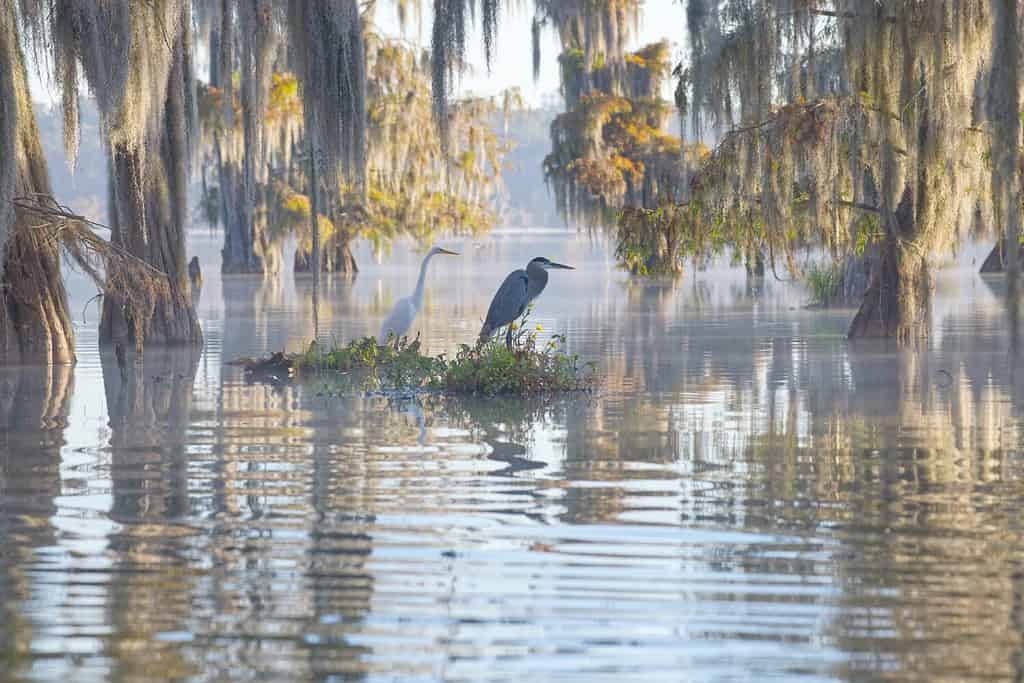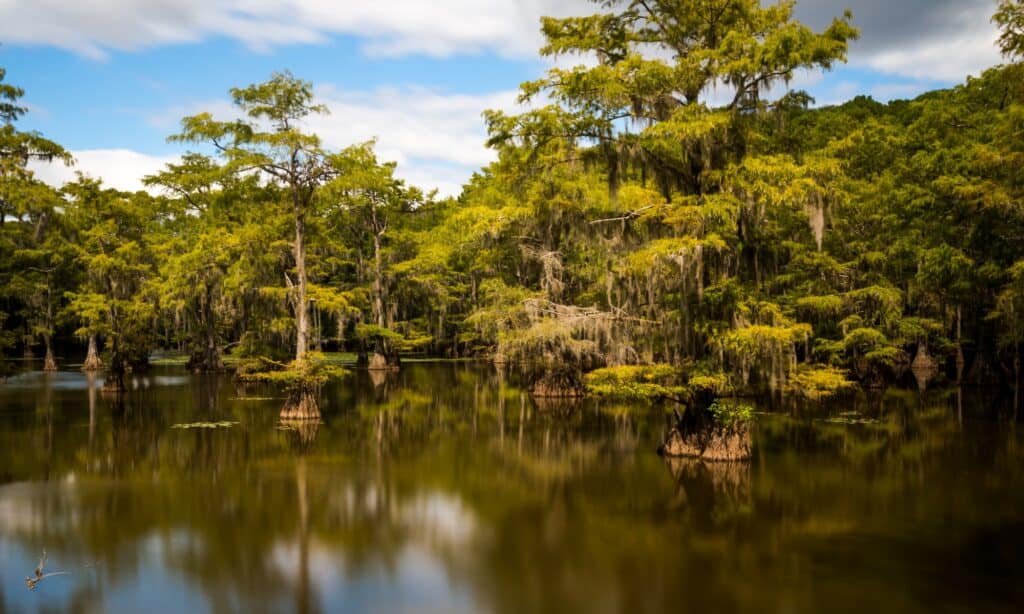Lurking on the border between Texas and Louisiana, Caddo Lake emerges as a captivating natural wonder steeped in mystery. As the whispers of legends entwine with scientific theories, the true history of its formation remains an enigma. We delve into the depths and width of this curious lake – a waterway that has bewitched explorers for centuries. We also compare its size to other lakes in Texas to help you better understand its magnitude!
How Wide is Caddo Lake?

Amid the swamps of Texas lies Caddo Lake.
©Xiu Yu Photography/Shutterstock.com
It appears that the width of Caddo Lake in Texas is not explicitly documented. However, there is a bridge called the Caddo Lake Bridge that crosses the lake, with a length of 967 feet. By considering the length of the bridge, we can make a rough estimation of the width of Caddo Lake. To accurately determine if the bridge spans the widest portion of the lake, consult official documents, maps, or local authorities.
Caddo Lake Bridge
Caddo Lake Bridge is located northeast of Mooringsport in Caddo Parish, Louisiana, near Caddo Lake. It is also known as the Mooringsport Bridge or the LA 1 Bridge. It is a notable vertical-lift bridge that is listed on the U.S. National Register of Historic Places. The bridge carries Louisiana Highway 1 (LA 1) over Caddo Lake, connecting the communities of Mooringsport and Oil City. The Caddo Lake Bridge is an important landmark in the region and a connection point for travelers crossing the lake.
Lake Dimensions
The lake covers approximately 25,400 acres (10,300 hectares) and is located on the border between Texas and Louisiana. It is much longer than it is wide; however, the exact length of the lake is not well documented. This lake is a complex system of bayous, wetlands, and backwaters, with an average depth of 8 feet. The deepest part of Caddo Lake is in the Big Cypress Bayou, with an average depth of approximately 20 feet.
While Caddo Lake has notable features and ecological significance, it is not a deep body of water. The lake is known for its cypress swamp and is surrounded by beautiful scenery and abundant wildlife.
What Is the History of Caddo Lake’s Formation?

Beautiful long-exposure image at the Caddo Lake State Park in Texas, USA.
©Victoria Ditkovsky/Shutterstock.com
The exact origin and formation of Caddo Lake are shrouded in myth and are subject to different theories. One legend mentions that the lake was formed by an earthquake caused by a Caddo chief’s failure to obey the Great Spirit. Another theory mentioned is that the lake formed over hundreds of years prior to the reported earthquakes, possibly through the flooding of natural depressions or river channels.
It is important to note that the formation of Caddo Lake is not scientifically confirmed, and different sources may offer different explanations based on historical records, Native American legends, or geological theories. Nonetheless, the origin of the lake is certainly a fascinating topic that has intrigued and mystified the masses for centuries.
Width Of Caddo Lake Compared to Other Nearby Lakes

Caddo Lake, located in Northwestern Louisiana on the Texas border, is known for excellent fishing.
©iStock.com/westtexasfish
Some other notable lakes near Caddo Lake in Texas include:
Lake Texoma:
Located to the north of Caddo Lake, Lake Texoma is one of the largest reservoirs in Texas, known for its recreational activities and fishing opportunities. While the specific width of Lake Texoma is not mentioned in any given search results, it is known to cover an impressive surface area of approximately 89,000 acres. It stretches across the Red River, with sources such as the Red River from the west and the Washita River from the north contributing to its waters.
Lake Amistad:
Situated in southwestern Texas, Lake Amistad is another prominent reservoir, offering various outdoor activities such as boating, fishing, and camping. Search results do not provide specific information about the width of Lake Amistad either. However, Lake Amistad is known to be a sizable reservoir located on the Rio Grande, primarily situated in Val Verde County, Texas. It encompasses a substantial surface area of approximately 64,900 acres, and the depth of the lake can reach up to 217 feet.
Lake Livingston:
Positioned to the southwest of Caddo Lake, Lake Livingston is a sizable reservoir in the East Texas Piney Woods and is owned and operated by the Trinity River Authority. It is known for its fishing opportunities and scenic beauty. According to a sedimentation survey conducted in 1991, Lake Livingston has a length of 55 miles and an average width of 0.42 miles.
Toledo Bend Reservoir:
Toledo Bend Reservoir is a significant body of water situated on the Sabine River, spanning the border between Texas and Louisiana. This reservoir has an area of approximately 185,000 acres and is recognized as the largest man-made body of water in the South of the United States.
Certain search results indicate the lake is 15 miles across at its widest point. Also, the reservoir has an estimated shoreline of 1,264 miles, offering ample space for various recreational activities.
Sam Rayburn Reservoir:
Sam Rayburn Reservoir, located in Deep East Texas, has a length of approximately 36.4 miles and a maximum width of 4.29 miles according to many sources. It is operated by the United States Army Corps of Engineers and is a popular fishing destination known for its largemouth bass, crappie, catfish, white bass, and sunfish populations. The reservoir’s width provides ample space for water-based activities.
Why Most Lakes Do Not Have An Average Width Listed For Them
Lakes do not commonly have an average width listed because the size and shape of lakes can vary significantly. The width of a lake is measured at a specific point, usually the widest part, but lakes can have irregular shapes and changing widths in different areas. Additionally, the width of a lake can change due to factors such as water levels, erosion, or sedimentation over time. Instead, lakes are often described in terms of their surface area or length, as these measurements provide a more comprehensive understanding of their size.
In Conclusion
Determining the average width of lakes can be challenging. These bodies of water often have irregular shapes and varying dimensions. One point of reference that offers insight into the width of the lake is the Caddo Lake Bridge. This bridge provides us with a tangible idea of the lake’s width (967 feet) at a particular point.
The absence of a listed average width is common when it comes to many lakes. The diverse shapes and contours of lakes make it difficult to quantify their width accurately. Instead, lakes are often described in terms of their surface area or length. These measurements provide a broader understanding of their size.
Lake Caddo, like many other lakes, showcases the uniqueness and complexity of nature’s creations. Its irregular shape reminds us of the intricate patterns and varied dimensions found in natural water bodies. While we may not have specific metrics to define Lake Caddo’s width, we can appreciate the beauty and mystery it holds as a remarkable part of our natural landscape.
The photo featured at the top of this post is © MeganTea/Shutterstock.com
Thank you for reading! Have some feedback for us? Contact the AZ Animals editorial team.







